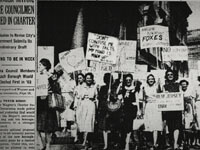Controlled Burn on Sunday in Great Swamp Postponed Due to Weather
Published on March 04, 2017
FIRE PLANNED FOR HARDING AREA MAY OCCUR DURING THE WEEK
 (JPG, 47KB)The U. S. Fish & Wildlife Service has postponed a controlled burn on wetlands at the Great Swamp National Wildlife Refuge in Harding that had been scheduled for Sunday (March 5) due to weather issues.
(JPG, 47KB)The U. S. Fish & Wildlife Service has postponed a controlled burn on wetlands at the Great Swamp National Wildlife Refuge in Harding that had been scheduled for Sunday (March 5) due to weather issues.
The forecast for Sunday calls for humidity that is too low and wind gusts that will be too high to allow for a safe burn. The Fish & Wildlife Service says it may reschedule the burn for later in the week, again dependent on weather conditions.
When the planned burn takes place, the refuge, Visitor Center, and Wildlife Observation Center will remain open to the public. However, Pleasant Plains Road and associated parking areas will be closed from just south of the Visitor Center parking lot to the South Gate of the refuge. (PNG, 9KB)
(PNG, 9KB)
Cyclists also are cautioned to seek alternate routes through the area, which is a popular bicycling route.
The planned burn is one of a series of controlled fires employed by the Fish & Wildlife Service starting last fall and expected to burn a total of 490 acres across three impoundments. Use of a prescribed fire to restore habitat is part of the refuge's Comprehensive Conservation Plan, which was finalized in 2014.
Great Swamp National Wildlife Refuge was established in 1960, in part, to provide habitat for migrating ducks and geese (waterfowl), and for the conservation of the nation's wetlands. Five artificial wetlands, also called impoundments, were constructed in the early 1970s and 1980s to provide migrating, nesting, brood-rearing, and feeding habitat for waterfowl. (JPG, 12KB)
(JPG, 12KB)
Over the past decade, woody vegetation has invaded three impoundments and standing dead vegetation has formed thick mats, reducing the amount of open water available for waterfowl.
The U.S. Fish and Wildlife Service regularly conducts prescribed burns on refuge lands to maintain and restore habitat for wildlife. The goal of these prescribed burns is to increase the amount of open water available to waterfowl by reducing the amount of standing dead vegetation and invading woody vegetation in three of the impoundments.
 (JPG, 13KB)Once restored, these impoundments will provide better feeding, nesting, brood rearing, and resting habitat for all waterbird species that use the refuge. In addition to improved habitat, visitors to the refuge also benefit from prescribed burns because fire promotes native species and habitats, thus increasing wildlife observation opportunities.
(JPG, 13KB)Once restored, these impoundments will provide better feeding, nesting, brood rearing, and resting habitat for all waterbird species that use the refuge. In addition to improved habitat, visitors to the refuge also benefit from prescribed burns because fire promotes native species and habitats, thus increasing wildlife observation opportunities.
Existing refuge roads and mowed fire lines around the burn units will be used to contain the fire within the burn units. Trained fire personnel with specialized equipment will ignite, monitor, and control the fire and its resulting smoke. In addition, water will be released back into the impoundments upon completion of the burns. Local emergency personnel, including the local police and fire departments, have been notified prior to each prescribed burn.
For additional information, please visit the Refuge website or contact the Great Swamp National Wildlife Refuge office at 973-425-1222, ext. 157.